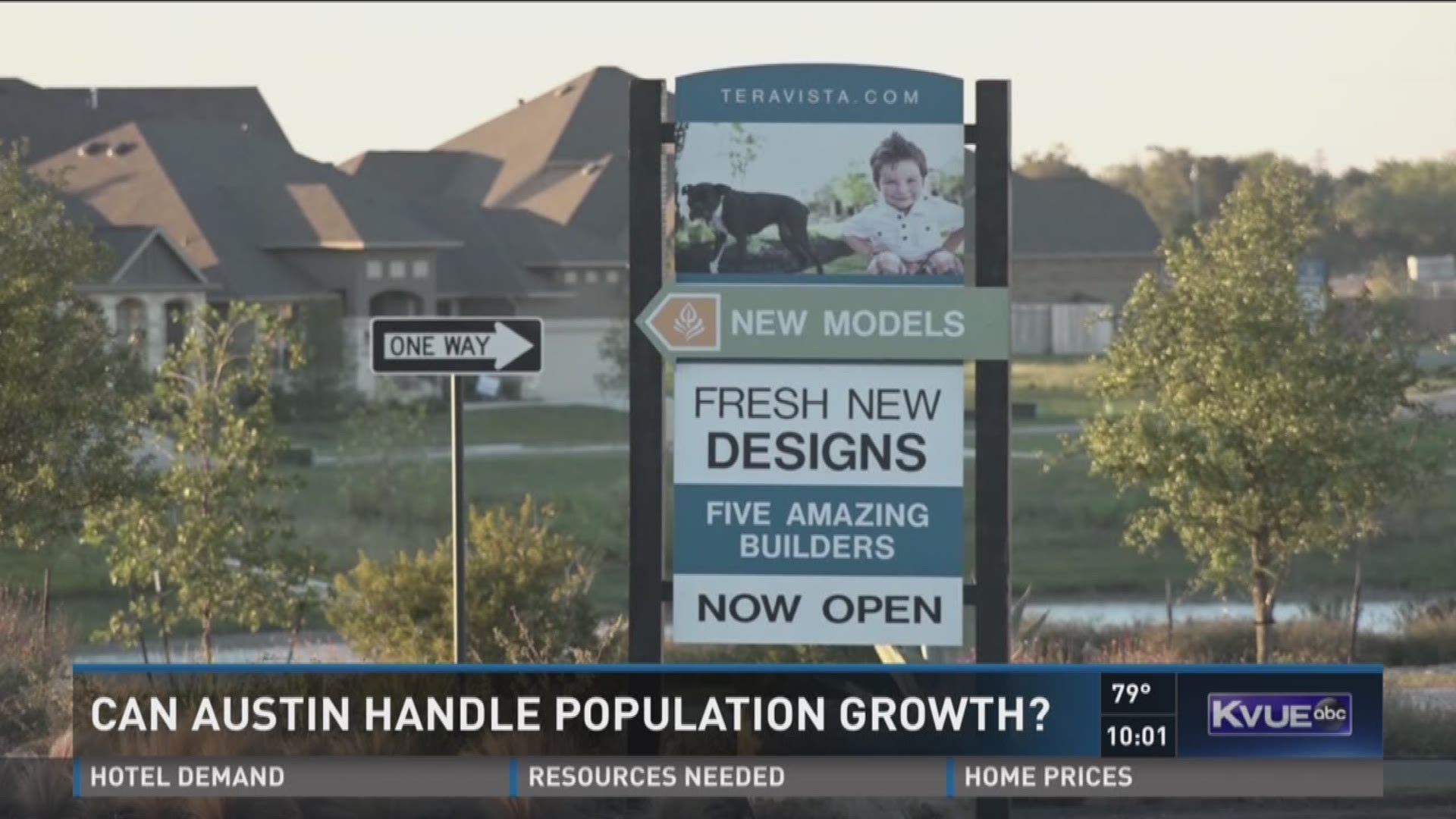How will Austin handle population growth?

This city is crowded. It comes as no surprise to Austinites. And it's only getting worse. The city's population is expected to increase to nearly 4 million people by 2040. How is Austin going to handle this growth? KVUE decided to find out.
THE DEMAND FOR HOUSING
The median home price in Austin has skyrocketed from $182,500 in 2006 to $289,990 in 2016. Realtors said that this growth is causing a shift in population.
"One thing to look at is the areas outside of the metropolitan areas," said Remax Associates Group Realtor Julie Downs. "Buda and Hays in the month of September had incredible growth, nine percent increase in their market, 350 home sales, which is great all the areas surrounding Austin are experiencing tremendous growth."
The problem is that prices are also rising in Hays County where the median home price right now is $253,250. It is up nearly 8 percent in the last month.
This growth is causing an increase in the number of people who are forced to rent because they can't afford to buy a home. Forty-seven percent of renters in Austin said that they are renting because they can't afford to purchase.
Buyers are advised to look for down payment assistance programs and first-time buyer help. They are also advised to buy now because the prices are only expected to increase. We are definitely in a seller's market.
THE DEMAND FOR HOTELS
The housing market isn't the only thing exploding in Austin. People are traveling here in record numbers -- both for work and for play.
Austin Bergstrom International Airport representatives report passenger travel is continuing to grow year by year.
In the last 12 months, about 12.2 million people traveled through ABIA. The year before that, about 11.4 million traveled through the airport. That is a 7 percent increase in passenger travel in the last year, amounting to 12.2 million people traveling through ABIA.
Many of those people are staying in hotels and the demand for rooms is increasing.
Many people are calling Austin a developer's dream, which is why more and more companies are choosing Austin as a prime area to build.
"Developers really see Austin as a great place to come in and invest in product because they know we're doing a very good job in selling that product," said Shilpa Baker with the Austin Convention and Visitors Bureau.
Those behind the Austin-based development company New Waterloo agree, saying their two properties, South Congress Hotel and Hotel Ella, have been very successful.
"Our hotels run in the 80 percent occupancy range, which is pretty much the norm for Austin right now and probably about 20 points above average for most hotels in most communities in the U.S.," New Waterloo partner Bart Knaggs said.
So far, 2016 has been a big year for the hospitality industry in Austin.
Tourism officials report by the end of this year, three new hotels will have opened, adding more than 3,000 rooms.
Over the last decade, demand has increased by about 5 percent each year and the supply of rooms have kept pace.
The Austin Convention and Visitors Bureau reports the average price for a room in the Austin metro is amounting to about $130 dollars per night.
Find more information from The Austin Convention and Visitors Bureau here.
THE DEMAND FOR WATER
One of the things people may not consider as homes and hotels continue being built are the resources available to those who inhabit them.
All of Austin's drinking water comes from natural resources -- either aquifers or reservoirs. As droughts have shown us in the past, those resources can vanish quickly.
Currently, rainwater replenishes our underground aquifers and brings more water into the Colorado River. That water flows from northwest Texas down to Austin, where we have a series of dams and reservoirs to collect it.
Growing population means not only more people, but more industry and potentially more agriculture. Development puts a strain on the river.
The Colorado River Alliance has been working on this problem. They developed a game to teach kids how difficult it might be for us to last until 2040 with a population boom.
The game puts the player in the shoes of a city planner making decisions as the population grows. Do you store water for the future? Dam a new lake? Or put money into scientific research for new solutions?
Executive Director of the Colorado River Alliance Brent Lyles said that decisions such as watering your lawn less or making sure to turn off the water when you brush your teeth can add up.
PUTTING IT IN CONTEXT
To put all of this in context, we looked at the median home prices for metropolitan areas with populations similar to Austin.
In 2015, Austin's population was 2 million. Charlotte, N.C. has a population of 2.4 million and Indianapolis, IA has 1.9 million people. But the median home price in Austin exceeds Charlotte and Indianapolis by quite a bit.
In the Austin area, the median price of a home is $225,000. In the Charlotte metropolitan area the median home prices is $138,000 and in Indianapolis it is $114,450.
In 2040, Austin's population is expected to be double what it is today. Cities in that projected population range include Detroit with a population of 4.3 million people, Phoenix with a population of 4.5 million people and San Francisco with a population of 4.6 million people.
A home in the Detroit metropolitan area costs $147,000. In Phoenix, the median home price is $205,000 and in San Francisco a home would cost around $700,000.
Like most facts and figures, median home prices aren't the only statistic that predicts success. Other elements are certainly a factor. But it leaves us wondering: Will Austin become a San Francisco or Detroit? Or can we keep the home price more manageable as the city grows?


